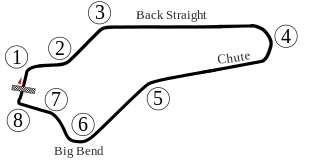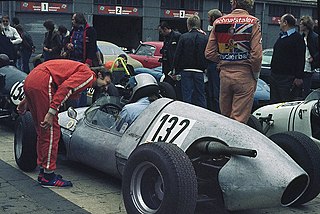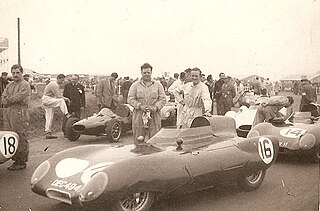Related Research Articles

The Ford GT40 is a high-performance endurance racing car designed and built by the Ford Motor Company. It grew out of the "Ford GT" project, an effort to compete in European long-distance sports car races, against Ferrari, who had won the prestigious 24 Hours of Le Mans race from 1960 to 1965. Ford succeeded with the GT40, winning the 1966 through 1969 races.

The Porsche 804 is a single-seat, open-wheeled racing car produced by Porsche to compete in Formula One (F1). It raced for a single season in 1962 in the 1½ litre formula.

The DFV is an internal combustion engine that was originally produced by Cosworth for Formula One motor racing. The name is an abbreviation of Double Four Valve, the engine being a V8 development of the earlier four-cylinder FVA, which had four valves per cylinder.

The 1963 United States Grand Prix was a Formula One motor race held on October 6, 1963, at the Watkins Glen Grand Prix Race Course in Watkins Glen, New York. It was race 8 of 10 in both the 1963 World Championship of Drivers and the 1963 International Cup for Formula One Manufacturers. The 110-lap race was won by BRM driver Graham Hill after he started from pole position. His teammate Richie Ginther finished second and Lotus driver Jim Clark came in third.

Formula Junior is an open wheel formula racing class first adopted in October 1958 by the CSI. The class was intended to provide an entry level class where drivers could use inexpensive mechanical components from ordinary automobiles. The idea to form the new class came from Count Giovanni "Johnny" Lurani who saw the need of a class for single-seater racing cars where younger drivers could take their first steps. It is often speculated that this class was founded as a reaction to Italy's lack of success in the 500cc Formula Three, and although Italian marques dominated the first year of the formula, they were soon overtaken by British constructors.

The Lotus 32 was a Formula 2 racing car built by Team Lotus in 1964. It was developed from the Lotus 27 Formula Junior model. Twelve cars were produced, four of which were run by Ron Harris Team Lotus, whose drivers included Jim Clark and Mike Spence. Spence won the 1964 Autocar British Formula 2 Championship while Clark was fourth in the Trophées de France Championship.

Elva was a sports and racing car manufacturing company based in Bexhill, then Hastings and Rye, East Sussex, United Kingdom. The company was founded in 1955 by Frank G. Nichols. The name comes from the French phrase elle va.
Hewland is a British engineering company, founded in 1957 by Mike Hewland, which specialises in racing-car gearboxes. Hewland currently employ 130 people at their Maidenhead facility and have diversified into a variety of markets being particularly successful in electric vehicle transmission supply.

The Lotus 18 was a race car designed by Colin Chapman for use by Lotus in Formula Junior, Formula Two, and Formula One.

The Brabham BT49 is a Formula One racing car designed by South African Gordon Murray for the British Brabham team. The BT49 competed in the 1979 to 1982 Formula One World Championships and was used by Brazilian driver Nelson Piquet to win his first World Championship in 1981.
Eric Harrison Broadley MBE was a British entrepreneur, engineer, and founder and chief designer of Lola Cars, the motor racing manufacturer and engineering company. He was arguably one of the most influential automobile designers of the post-war period, and over the years Lola was involved with many high-profile projects in Formula One, IndyCar, and sports car racing. Broadley sold Lola to Martin Birrane in 1999.

The McLaren M7A and its M7B, M7C and M7D variants were Formula One racing cars, built by McLaren and used in the world championship between 1968 and 1971. After two relatively unsuccessful years of Formula One competition, the M7A was used to score McLaren's first win at the 1968 Belgian Grand Prix.

The Lotus 22 was a racing car built by Lotus cars in 1962, and a total of 77 cars were built. It was developed from the 1962 Lotus 20, with the major differences that it had disc brakes all round, a top link and the 'rubber donut' to the rear suspension and a dry sump engine that was canted over to lower the centre of gravity. Also notable is the smoother bodywork covering the engine, compared to the boxy design of the 20.
Four-wheel drive (4WD) has only been tried a handful of times in Formula One. In the World Championship era since 1950, only eight such cars are known to have been built.

The Cooper T51 was a Formula One and Formula Two racing car designed by Owen Maddock and built by the Cooper Car Company for the 1959 Formula One season. The T51 earned a significant place in motor racing history when Jack Brabham drove the car to become the first driver to win the World Championship of Drivers with an engine mounted behind them, in 1959. The T51 was raced in several configurations by various entrants until 1963 and in all no less than 38 drivers were entered to drive T51s in Grand Prix races.

The BRM P261, also known as the BRM P61 Mark II, is a Formula One motor racing car, designed and built by the British Racing Motors team in Bourne, Lincolnshire, England. The BRM P261 was introduced for the 1964 Formula One season, and its design was an evolution of Tony Rudd's one-off BRM P61 car of 1963. The P261 had a relatively long racing career; variants of the car were still being entered for Formula One World Championship Grands Prix as late as 1968. During the course of their front-line career BRM P261s won six World Championship races, in the hands of works drivers Graham Hill and Jackie Stewart, and finished second in both the Drivers' and Constructors' Championship standings in 1964 and 1965. Stewart, Hill and Richard Attwood also used works P261s to compete in the Tasman Series in 1966. The BRMs dominated, with Stewart winning four, Hill two, and Attwood one of the 1966 Tasman Series' eight races. Stewart also won the title. The works-backed Reg Parnell Racing team returned in 1967 with Stewart and Attwood, where Stewart added another two wins to his tally. In terms of races won and total Championship points scored, the P261 was the most successful car in BRM's history.

The Brabham BT3 is a Formula One racing car. It was the first Formula One design to be produced by Motor Racing Developments for the Brabham Racing Organisation, and debuted at the 1962 German Grand Prix. The Brabham BT3 was the vehicle with which team owner – then two-time World Champion – Jack Brabham, became the first driver ever to score World Championship points in a car bearing his own name, at the 1962 United States Grand Prix. The following year Brabham also became the first driver ever to win a Formula One race at the wheel of an eponymous car, again driving the BT3, at the 1963 Solitude Grand Prix. The BT3 design was modified only slightly to form the Tasman Series-specification Brabham BT4 cars.

John Crosthwaite was an English race car designer and engineer, active in both the United Kingdom and the United States.
Colchester Racing Developments produced Merlyn racing cars from 1960 to 1979. The company was founded by Clive Maskrey, Selwyn Hayward and continued by Hayward's brother, Clive. When the manufacture of Merlyn racing cars stopped, Clive Hayward continued to manufacture Merlyn parts as CRD Tool and Engineering Ltd. This company stopped trading in November 2015, but Clive Hayward continues to run Colchester Racing Developments, manufacturing Merlyn components and carrying out chassis repairs.

William George Sadler designed, built, and drove his own sports racing cars, some of which anticipated the later Formula 5000 and Can-Am cars. He left racing and earned a Masters of Electrical and Electronics Engineering, then went on to design and build light aircraft and aircraft engines, and was involved in the early development of Unmanned aerial vehicles (UAVs).
References
- ↑ Globe and Mail, October 4, 1963, Page 43.
- 1 2 "Stebro Profile". Grandprix.com. Inside F1. Retrieved 2011-05-29.
- ↑ Motor Sport, November 1963, Pages 879, 881, 882.
- ↑ Competition Press & Autoweek, Oct 9, 1965, Page 3.
- ↑ "Stebro - About". Stebro. Retrieved 2011-05-29.
- ↑ Results taken from Formula1.com